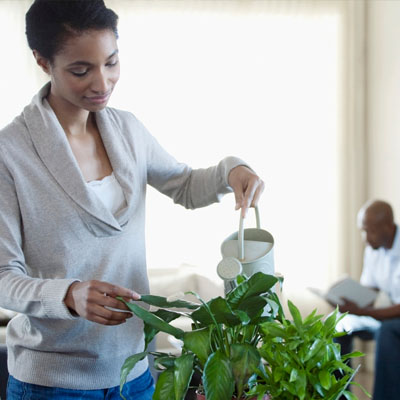Create a Winter Garden to Cheer Up Your Dark Days

Plants are mankind’s best friends. They are beautiful. They provide sustenance for body and soul. They recycle our carbon dioxide and turn it into oxygen. Quite simply put, we humans would quickly disappear from the face of the earth if totally deprived of green life.
Maybe that’s why people just like being around plants. As early as 3000 B.C. the Chinese were using medicinal herbs. The Greeks created healing gardens as a setting for their temple to Aesclepius, god of healing. In colonial America, the Quakers used garden therapy as a means to restore the soul. A horticulture therapy program was established in 1879 at Friends Hospital in Philadelphia after a physician noticed that working in the hospital’s flower garden seemed to calm the psychiatric patients. This phenomenon is widely embraced by medical and mental health professionals today, and many modern hospitals strive to incorporate green spaces and plants to encourage healing.
Scientists have also learned that indoor plants are key in removing toxins from the air we breathe. Air conditioning, synthetic building materials, and inadequate ventilation can bring on numerous respiratory and nervous disorders. The mere presence of plants helps lessen these environmental pollutants.
In the 1970s, B.C. “Bill” Wolverton, an environmental scientist, did ground-breaking research with NASA about how to create sustainable enclosed living environments for potential use in space. The NASA Clean Air Study, performed in association with the Associated Landscape Contractors of America (ALCA), proved that certain common indoor plants can naturally remove benzene, formaldehyde, and trichloroethylene from the air.
The researchers suggested at least one plant per 100 square feet of home or office space for efficient air cleaning. An overview of NASA’s and Dr. Wolverton’s findings is provided below.
| Plant, removes: | benzene | formaldehyde | trichloroethylene | xylene and toluene |
| Areca palm (Dypsis lutescens) | no | no | no | Yes |
| Boston fern (Nephrolepis exaltata ‘Bostoniensis’) | no | Yes | no | Yes |
| Dumb canes (Dieffenbachi) | no | no | no | Yes |
| English ivy (Hedera helix) | Yes | Yes | Yes | Yes |
| Heartleaf philodendron (Philodendron cordatum) | no | Yes | no | no |
| Peace lily (Spathiphyllum) | Yes | Yes | Yes | Yes |
| Red-edged dracaena (Dracaena marginata) | Yes | Yes | Yes | Yes |
| Rubber plant (Ficus elastica) | no | Yes | no | no |
| Spider plant (Chlorophytum comosum) | no | Yes | no | Yes |
| Variegated snake plant, mother-in-law’s tongue (Sansevieria trifasciata) | Yes | Yes | Yes | Yes |
| Weeping fig (Ficus benjamina) | no | Yes | no | Yes |
Build a Terrarium
Lacking space but still interested in enjoying the health benefits of indoor plants? Turn a large jar or small fish tank into your own personal therapy garden. This is a fun activity for adults and kids. Here are some tips to get you started.
- Select a clear glass container that has a mouth wide enough to get your hand inside. A closed terrarium looks neat, and is great for humidity-loving plants, but it may be difficult to keep it cool inside and your plants may wilt. For your first try, use something that has a top you can remove periodically or leave partially open to allow air circulation.
- Clean the interior well to discourage bacteria growth. Lay a handful of pebbles at the bottom to provide drainage.
- Next, you might wish to sprinkle a quarter-cup of activated charcoal on top of the stones. This will help keep your terrarium smelling fresh, but it is optional.
- Another nice touch is to place some dampened sphagnum moss on top of the stones to keep the soil from falling into the rocks.
- Use a scoop to add potting soil. You will need three to four inches of soil to support healthy plant life, but leave plenty of “head room” for your green tenants. Together with the drainage layer, the soil should take up about one-third the height of your container.
- Select three or four small plants that are tolerant of low light and enjoy humidity. Good choices are ferns, mini-palms, ivy, schefflera, peperomia, and baby’s tears.
- Place the tallest plant first and then fill in with smaller ones.
- Once you are satisfied with plant placement, cover any bare soil with additional sphagnum moss. Use a spray bottle to wash down moss or soil particles that have clung to the interior walls.
- Place your mini-garden in a bright location where it will enjoy filtered or indirect sun. The soil should be damp, but not saturated.
That’s it! Don’t forget to enjoy your tiny ecosystem. Check on it regularly and remove dead leaves. If you see that the terrarium walls are clouding up, remove the top and let in some air.
It’s fun to see how long you can keep your glass garden alive. Moderation is the key to success. Too much heat will burn the leaves and too much water will lead to decay. But if you notice that the plants have outgrown the container or become spindly and weak, don’t feel guilty, just learn from your experience and build again.
 The Daily Dose
The Daily Dose
Comments are closed.